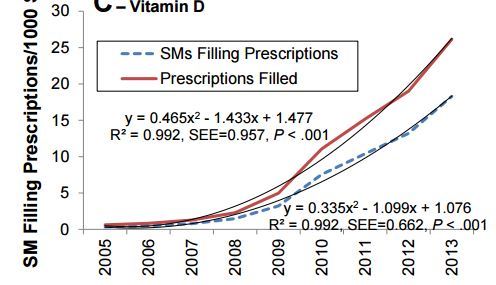Huge increase in Vitamin D supplementation in the US military (2005-13)
Temporal trends in dietary supplement prescriptions of United States military service members suggest a decrease in pyridoxine and increase in vitamin D supplements from 2005 to 2013

SM = Service Members
Nutrition Research, Volume 36, Issue 10, October 2016, Pages 1140–1152. http://dx.doi.org/10.1016/j.nutres.2016.09.001
Joseph J. Knapika, b, c, , , Rosenie T. Jeand, , Krista G. Austina, c, , Ryan A. Steelmanb, , Julia Gannond, , Emily K. Farinaa, c, , Harris R. Liebermana,
📄 Download the PDF from VitaminDWiki
Dietary supplements (DSs) can be obtained over-the-counter but can also be prescribed by health-care providers for therapeutic reasons. Few studies have documented this later source despite the fact that 79% of physicians and 82% of nurses have recommended DSs to patients. This investigation assessed prevalence and temporal trends in oral DS prescriptions filled by all United States service members (SMs) from 2005 to 2013 (n = 1 427 080 ± 22 139, mean ± standard deviation (SD)/y). We hypothesize that there would be temporal variations in specific types of DSs. Data obtained from Department of Defense Pharmacy Data Transaction System were grouped by American Hospital Formulary System pharmacologic-therapeutic classifications and prevalence examined over time. About 11% of SMs filled one or more DS prescriptions of 235 180 ± 4926 (mean ± SD) prescriptions/y over the 9-year period. Curve-fitting techniques indicated significant linear declines over time for multivitamins (P = .004), iron preparations (P < .001), antacids (P < .001), and vitamin B and B complex vitamins (P < .001). There were significant quadratic trends indicating a rise in early years followed by a leveling off in later years for replacement preparations (P < .001) and vitamin C (P < .001). There were significant quadratic trends (P < .001) for vitamin E indicating a decline in early years and leveling off in later years, and vitamin D indicating little change in early years followed by a large rise subsequently (P < .001). This study identified temporal trends in specific DS categories that may be associated with changing perceptions of prescribers and/or patients of the appropriate roles of DSs in medicine and public health.
